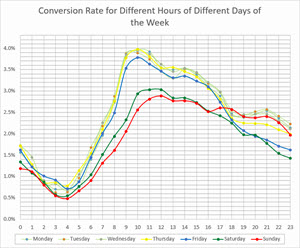Google Analytics reporting defaults to analyse your website performance on a daily basis. But it is straightforward to generate hour of the day reports, and also day of the week reports. You can download our free custom report templates, and create your own daily and hourly reports by following the detailed steps we share with you here.
We have created 7 free reports that you can import right now into your own Google Analytics account. In this post we also give you step by step guide to help you create your own reports.
- Hourly Traffic Report
- Day of the Week Traffic Report
- Hourly Conversion Rate Report
- Day of the Week Conversion Report
- Day of the Month Conversion Rate Report
- Hour & Day Traffic Report
- Hour & Day Conversion Report
Get your 7 hourly and daily report templates right now
Here is how you create your own hourly and daily reports yourself
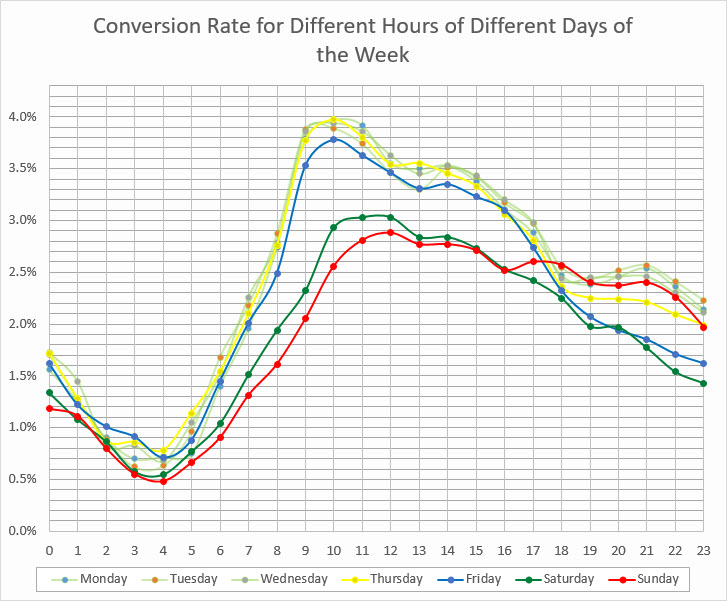
Google Analytics hour of day report
Most websites receive the majority of their visits during predictable periods of the day, which might be first thing in the morning, at lunchtime or in the early evening. We might assume that a business-to-business (B2B) website will be busiest during typical business hours, or an educational website will have low traffic volumes at night.
But these are just assumptions unless we have clear evidence to prove otherwise.
Having access to this data at a granular level, say on an hourly basis or a day of the week basis, might inform and influence our marketing strategies, and how we run our marketing campaigns.
This valuable data is being collected in your Google Analytics account, but it is not available to you unless you do a deep dive into the data and pull it out.
We made this easy for you by creating an Hourly Traffic Custom Analytics Report
In order to get the hourly report, just log in to your Analytics account, click on this link, and the report will be added immediately into your Custom Reports on Analytics.
Looking at Hallam‘s own report, we get both a graph and also a row by row hourly analysis. The top-performing hour is 14, meaning 14:00 or 2 pm.
And, perhaps somewhat surprisingly, we can see the peak times for visitors overall are from 13:00-15:00, corresponding to the late B2B lunch period:
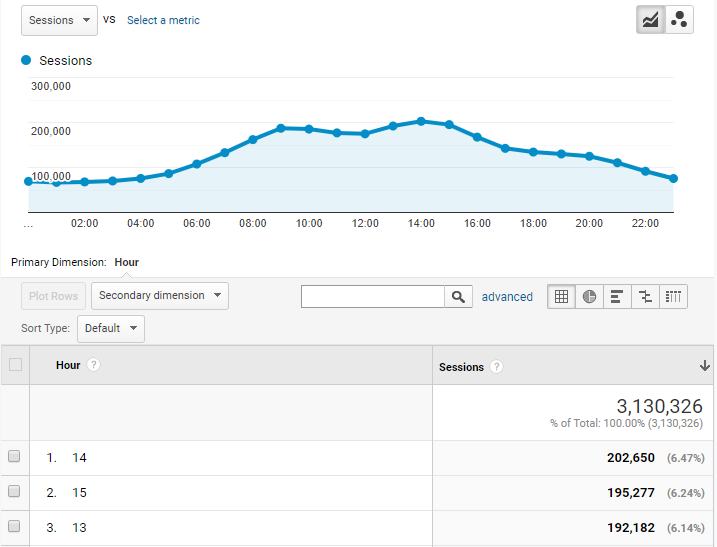
If you would like to see how we created this custom report, or if you prefer to create your own reports, here are the steps you need to take:
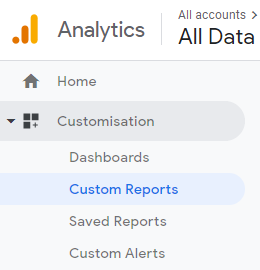

Add a “+ New Custom Report” from the “Customisation” tab and set up a new custom report with “Sessions” in the metric field and “Hour” in the dimension drill-down:
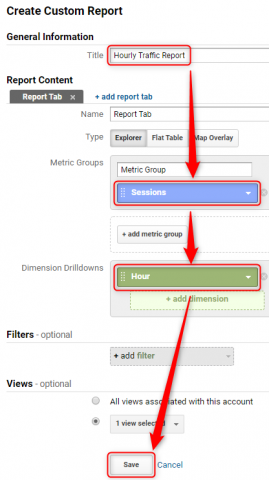
Make sure you pick a large date range in the top right corner. The more data you have, the clearer the results in the hourly report will be:
![]()
You can now see a graph and a data table with the number of sessions throughout the day:

Use this graph to identify the peak times of the day when the website receives traffic. If the peak is just before midnight, then consider adding a special offer on the website that ends at midnight to create a last-minute rush of sales. However, if the peak is around lunchtime, then make sure you promote the website by promoting heavily around 11 am, just before lunchtime, to draw in the biggest number of visitors.
If you have goals and/or e-commerce tracking set up on the website, then these can give you valuable insights on what time the website converts the best, independent of traffic levels.
Follow the steps below to create a 24-hour goal and e-commerce conversion rate report or click here to add this report automatically into Google Analytics once logged in:


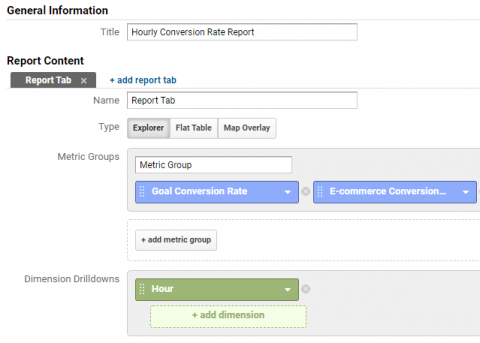
Again, ensure you pick a large date range in the top right corner once the report has run to get the best results.
Now you can see how well the website performs at different times of the day. You can switch between goal completions and e-commerce conversion rate using the drop-down just above the graph shown below. This is especially useful when adding bid adjustments on e-commerce PPC campaigns to boost overall profitability:

On all forms of paid advertising and social media, this report can highlight the exact times to ramp up efforts on both fronts to capture as many visitors as possible during times when they are most likely to convert.
If e-commerce tracking is installed correctly, remember to account for different average order values as well as the different conversion rates throughout the day. The effectiveness of the website during the day depends not only on how well the website converts at different times but also the average amount people spend during those times. An excellent metric for analysing this is the “Per Session Value”, which accounts for both the conversion rate and average order value.
Google Analytics day of week report
Having analysed hundreds of websites, we’ve seen that traffic is often likely to dip and have a lower conversion rate during the weekends.
Traffic levels can also be lower on Fridays when a large number of people are socialising, travelling, or watching their favourite TV shows for example.
There’s often surprising statistics from Monday to Thursday, with certain days having much higher conversion rates than others. For example, we’ve seen that many people make the biggest purchases online in the middle of the week (and often during work hours!).
There’s a great collection of Twitter & Blog post statistics over at BufferApp.com and Email sending statistics at OptinMonster, if you want to see how these specific channels vary at different times.
The statistics for different days of the week are important to look at so you can optimize your marketing activities. So whilst it can be fun to theorize why a certain day performs well, what’s really important is matching the real data. For example, the conversion rate for a teenage clothing website we promote increases by almost 22% on average on Thursdays. Why this happens, we don’t know. What’s important though, is that we know we can spend 22% extra per person with paid advertising on Thursdays, while ensuring that all social media channels save their best promotional content for this highly lucrative day.
Follow the steps below to create a Google Analytics Day of the Week traffic report or click here to add our Analytics Day of the Week traffic report automatically into Google Analytics once logged in:
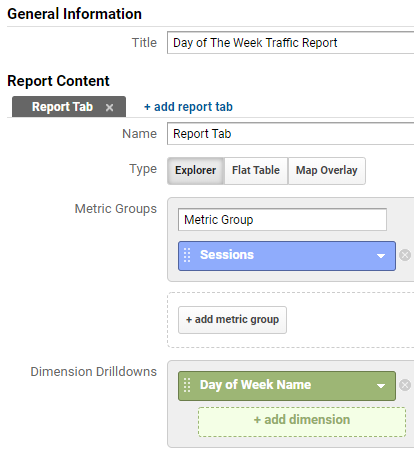
As always, ensure you pick a large date range in the top right corner for more accurate statistics:

Now we can see the average number of visitors (sessions) for each day of the week within the data table:
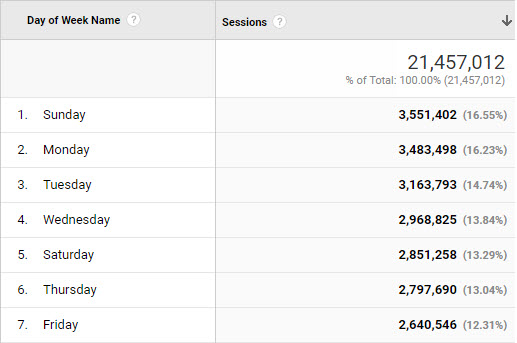
To compare statistics more easily, use the comparison tool next to the data chart:
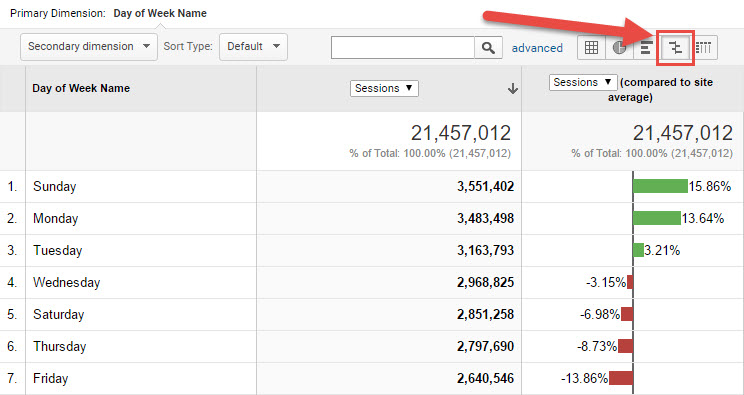
With the comparison tool, you can now compare each day to the average for all days. Red bars show a decrease and green bars show an increase compared to the average.
Again, if you have goals and/or e-commerce tracking setup then you can see what day of the week the website converts the best, independent of traffic levels. Follow the steps below to create a day of the week conversion report or click here to add this report automatically into Google Analytics once logged in:
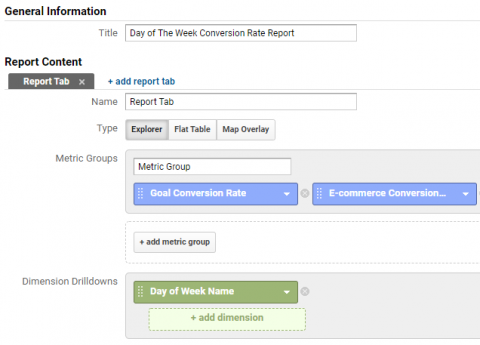
Remember to pick a long date range in the top right corner once the report has run or else these stats will unreliable.
Using the comparison tool will highlight the best and worst days of the week. This can help craft ideal time bid adjustments in Google Ads and when to boost social media activities:
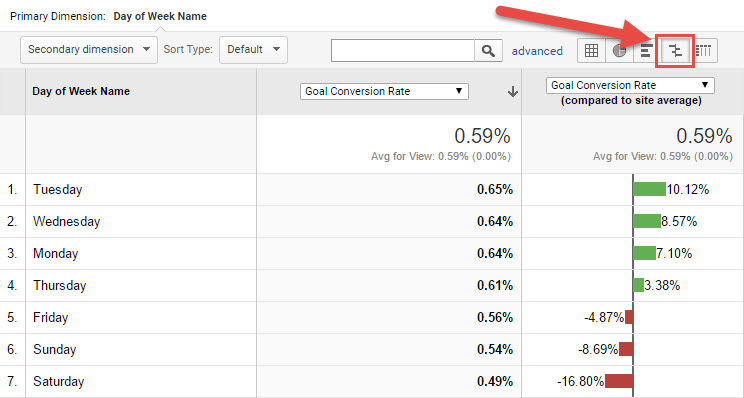
Advanced Google Analytics Time Reports
To get really accurate data, you may wish to combine the 24 hours of the day report with the 7 days per week report to get an hour-by-hour account of how your website performs on each day of the week. For example, traffic on many websites will be very different on a Friday morning compared to the same time on a Sunday morning. This report will highlight the differences.
This report is ideal for the time of day bid adjustments on paid advertising platforms, such as Google Ads or Microsoft Ads, which allow you to adjust bids at different times of the day and on different days of the week.
Simply add the “Hour” and “Day of the Week Name” dimensions to the same custom report and run it as before with a large date range. Click here to download the traffic report, or here to download the e-commerce and goal report if you want to skip this part once logged in to Google Analytics:
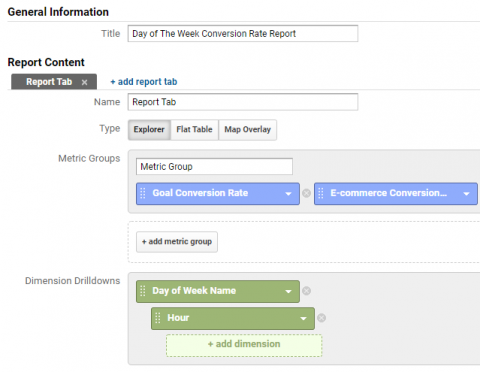
To get both the hours and days dimensions on the chart you have to reveal the secondary dimension and select the one not shown:
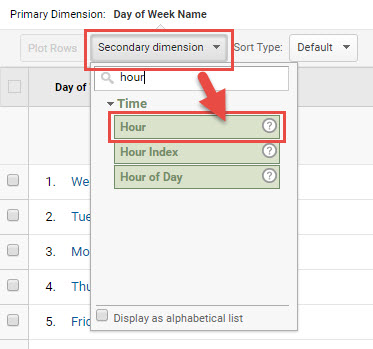
Then you need to show all rows and export the data into a spreadsheet:
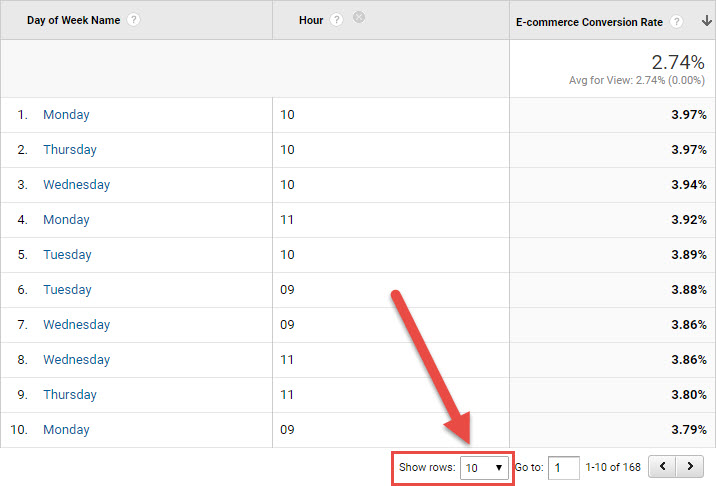
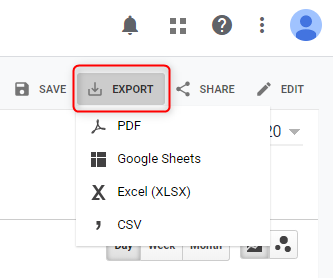
Using Microsoft Excel, or Google Sheets you can pivot this data into a usable graph showing conversion rates for each hour of each day of the week:

Notice that within the real statistics shown above, Saturday and Sunday are very similar in the day time, but Sunday has a much better e-commerce conversion rate than Saturday after 3 pm. Friday and Thursday evenings are also a poor time for converting compared to other weekdays.
Google Analytics day of month report
Another advanced report that may be of use would be looking at the day of the month conversion rate (click here for the automatic report). Simply select the “Day of the month” dimension and then export the data as shown in the previous report after showing all the rows of data within the table:

Again, using Excel spreadsheet techniques you can turn this data into a usable graph showing conversion rates for each day of the month:
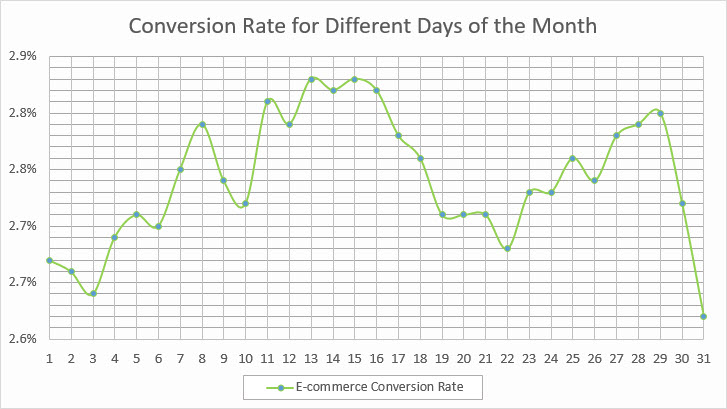
I suggest avoiding national holidays within these stats, especially Christmas time and Black Friday – between mid-November until the first week of January for most of the world. Christmas time gives unnaturally high traffic and conversion rates at the end of the month for many e-commerce sites and the opposite for many B2B websites.
If there is a trend for higher conversion rates during different days of the month, as there is in the example above, you can either manually lower your automated bidding targets in these periods, or create automatic Google Ads scripts to raise and lower bid adjustments (e.g. location targets) at the right times.
The example above has an upward trend around the middle of the month and the end of the month. Many people get paid at the end of the month which influences buying behaviour around the end and start of each month on most e-commerce websites. Luxury goods seem to have a mid-month boost in conversion rates whereas cheaper goods have a boost between near the end of the month and the first week of the month. But each website has different patterns and you should identify your own and never rely on other people’s trends.
Conclusion
Using Google Analytics Day of Week & Hour of Day Reports alongside traffic levels and goal or e-commerce conversion rates gives great insights into how people interact with your website.
And if you want to get all 7 reports now, here you go:
Get your 7 hourly and daily report templates right now
Finding any times that differ from normal statistics allows you to optimise paid advertising channels and to get more traction from social media or email campaigns.
Experiment with these custom reports and you can find a wealth of valuable data. When experimenting with custom reports, the worst that can happen is that you don’t see any data or anything of use. Nothing you do here will run the risk of breaking your site, and if you don’t like what you see, starting another report is easy, don’t be afraid to make your own custom reports!
Have any questions or issues? Comment below and I’ll get back to you shortly.

